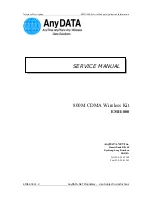
OPERATOR’S
MANUAL
CMA-9000 FLIGHT MANAGEMENT SYSTEM
Page
14-6
November 19, 2009
A. SIMUL FLY AWAY FUNCTION
Upon opening the SIMUL FLY AWAY 1/3 page or selecting the "RESTORE DEFAULTS" prompt on the
same page, the CMA-9000 FMS initializes to the default value (values received from other aircraft sub-
systems) the current gross weight, current baro-corrected altitude, current outside air temperature and
current wind. Then it computes the Fly away height (minimum height to maintain in hover or the maximum
drop in height upon loss of an engine during hover); OEI OGE weight (weight required to maintain the
specified barometric altitude without any drop in height upon loss of an engine); and OGE CEILING height
(minimum altitude at which the ground effect is no longer felt).
The pilot can modify the gross weight, Fly away height, barometric altitude, outside air temperature and
wind. If the gross weight is modified, a new Fly away height, OEI OGE weight and OGE CEILING height are
calculated; similarly, if a Flyaway height is entered, the function determines the required gross weight, OEI
OGE weight and OGE CEILING height. Manual entry is distinguishable by either displaying values in
reverse video (as in the case of the GROSS WT, FLY AWAY HT, BARO ALT fields) or large font size (as in
the case of OAT and WIND fields).
If one of the parameters is out of bounds or invalid, an advisory message is triggered (refer to Appendix E
for details).
B. SIMUL OEI CRUISE FUNCTION
Upon opening the SIMUL OEI CRUISE 2/3 page or selecting the "RESTORE DEFAULTS" prompt on the
same page, the CMA-9000 FMS initializes to the default value (values received from other aircraft sub-
systems) the current gross weight, present baro-corrected altitude and present outside air temperature.
Then it computes the jettison weight (weight to lose in order to maintain the current altitude) and the level
altitude (maximum altitude after engine loss if no weight is dropped).
The gross weight, barometric altitude and outside air temperature can be modified by the pilot to determine
different scenarios. Whenever a manual input is done, the gross weight and barometric altitude are
displayed in inverse video and the outside air temperature in large font.
If one of the parameters is out of bounds or invalid, an advisory message is displayed. If more than one
advisory message is activated only the highest priority message is displayed.
The messages "AIR TEMP NOT VALID", "BARO ALTITUDE NOT VALID", "GROSS WEIGHT NOT VALID",
"WIND NOT VALID", and "FLY AWAY HT NOT VALID" are displayed depending on the situation.
C. SIMUL
RTEx
FUNCTION
While in flight, upon opening the SIMUL RTEx 3/3 page or selecting the "DEFAULT VAL" prompt on the
same page, the CMA-9000 FMS initializes to the default value (values received from other aircraft sub-
systems) the current values of TAS, fuel flow, wind, and fuel weight. Then it computes the ETA/EFA for the
waypoints that are part of the inactive route.
The SIMUL RTEx 3/3 page shown on ground displays the following values:
•
CRZ TAS and CRZ WIND as defined in the PLAN DATA page;
•
Fuel flow is set at a value of 615 kg/hr;
•
Fuel weight is set at a value of 4000 kg.
The pilot can modify one or all the values on this page in order to compute different scenarios for the
ETA/EFA values. Manual entry is distinguishable by displaying the values in large font size.
This page is printed under user's responsibility
and must not be retained for reference


































![Navig[8]r NAVBIKE-GPS User Manual preview](http://thumbs.mh-extra.com/thumbs/navig-8-r/navbike-gps/navbike-gps_user-manual_3574097-01.webp)












